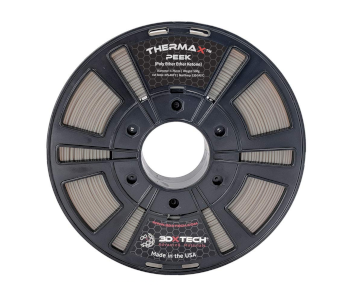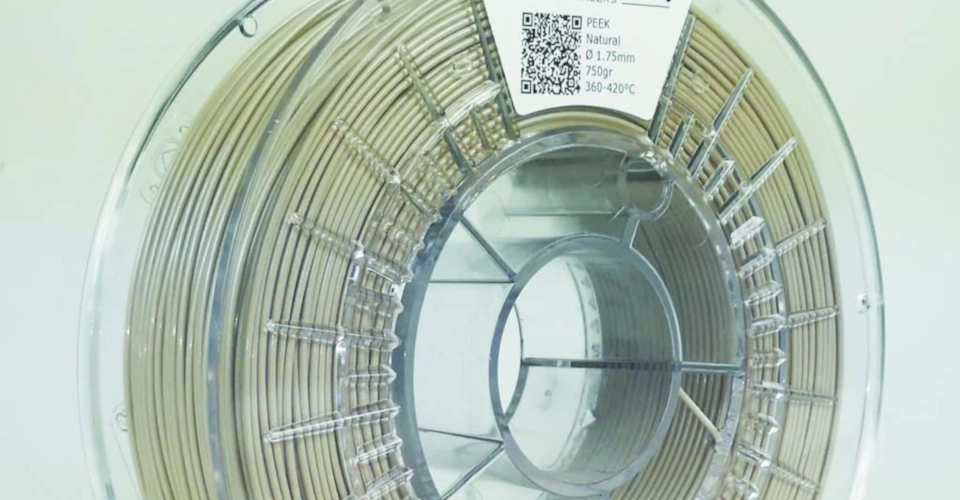High-Performance PEEK Filament: Properties, How to Use, and Best Brands
Objects made from 3D printing are known for capturing the imagination and turning it into reality, but they aren’t exactly known to be durable. Depending on the filament, your 3D print can melt in extreme temperature, quickly deteriorate when exposed to UV radiation, or fail spectacularly upon sustained or sudden impact.
Since 3D printing came into fashion, manufacturers of 3D printing filaments have made a lot of efforts to make products that are just a little more resilient and sturdier. One of the products of these efforts is PEEK filament. What makes PEEK filament so special? What are the best brands of PEEK filaments available today?
What is PEEK filament?
PEEK stands for Polyether Ether Ketone, a semi-crystalline thermoplastic that is well-known for its excellent mechanical strength and chemical resistance. It is created by a step-growth polymerization process conducted at very high temperatures. It has a high resistance to biodegradation, chemical degradation in organic and aqueous environments, and can have a useful operating temperature range of up to 250 °C. With a tensile strength of 90 to 100 MPa and a Young’s modulus of 3.6 GPa, PEEK is both rigid and strong.
Applications of PEEK can be derived either from its solid form or by 3D printing from its filament form. Because of its excellent physical and chemical properties, PEEK has been used to manufacture engineering parts such as piston parts, pumps, bearings, compressor valves, and electrical cable insulation. It has also been used in the field of medical implants, such as for replacement skeletal components. For these high-performance applications, PEEK is typically processed using extrusion or injection molding methods.
Properties of PEEK filament
PEEK belongs to a class that’s a little different than most of the other 3D printing filaments. It’s classified as a high-performance filament, which means that it exhibits better overall properties. However, this also corresponds to a much higher price tag. Here are the characteristics of PEEK filament that makes it quite unique:
1. Prints at very high temperature
We may consider ABS or Nylon as “high-temperature filaments,” but neither of those two even come close to the temperatures needed for PEEK. To print with PEEK, you need a 3D printer that can heat up to 360 to 400 °C. Correspondingly, you will need a heated bed that can be set to as high as 120 °C. This property sets PEEK filament apart immediately because not many desktop 3D printers are capable of achieving such temperatures. If you’re planning on printing with PEEK, you’ll have to be very discerning about the specs of your 3D printer.
2. Robust
The difficulties of printing with PEEK filament pay off when you realize just how robust the finished product is. As you would expect, PEEK has thermal stability unequaled in the world of 3D printing filaments. With thermal stability of up to 250 °C, PEEK is a suitable material for many engineering processes or medical instruments and prosthetics that need to be sterilized at high temperatures.
Like ABS or Nylon, prints made with PEEK filaments are also exceptionally strong and rigid. This makes PEEK suitable for functional parts that go through regular movement or are subjected to sudden or sustained pressure. It’s also very resistant to biodegradation and breakdown by UV radiation, which makes it an excellent material for items meant to be used or displayed outdoors.
3. Good layer adhesion
Because of the very high temperatures at which PEEK prints, it usually exhibits very good layer adhesion. This means that prints made with PEEK have almost equal strength across all three dimensions. However, this is a characteristic that you will only experience if you follow the proper 3D printing fundamentals. Since PEEK prints at very high temperatures, it also cools very rapidly as soon as it exits the nozzle. You will have to slow down this cooling process so that the filament remains just hot enough to create molecular bonds across the layers.
4. Very expensive
One of the major hurdles to the widespread use of PEEK filament is the fact that it’s very expensive – easily four to five times the cost of an equivalent spool of ABS or PLA. At this price tag, we don’t expect many casual 3D printing hobbyists to buy a spool of PEEK filament just to try it out. Although it’s perfectly understandable why PEEK is so expensive, we are hoping that improvements in technology and growing demand can drive down the prices soon.
PEEK is a very intimidating filament because of its high demands, in terms of both price and 3D printing parameters. It was never meant to be the type of filament that you could use to print things just for fun. It’s a high-performance filament that you only bring out when absolutely needed.
How to print using PEEK filament
Let us preface this section by saying that not many desktop 3D printers are capable of printing with PEEK. Not only do you need to have a heating element that can go to very high temperatures, but you’ll also probably need a high-end nozzle, printing bed, and a print bed enclosure. Before you decide on buying any PEEK filament, check out our guidelines first, so you’ll know if your 3D printer is up to the job.
PEEK prints at a temperature range of 360 to 400 °C. The optimal temperature may vary from one filament brand to another, but it’s best to be at the upper half of this range. Take note that the standard brass nozzle that comes as a stock with most desktop 3D printers may not be compatible with temperatures at this range.
A heated bed is necessary when printing with PEEK, and you’ll need to set it similarly high temperatures within the range of 130 to 145 °C. Because of the inherently high temperature difference between the filament and the surroundings, PEEK is very prone to warping. This means that you’ll have to apply some adhesion aid to the print bed to avoid having the base layer detach due to thermal deformation. Some sites recommend glue stick (which you may use in a pinch), but we prefer more thermally stable adhesives such as Kapton tape or hairspray.
The high printing temperature of PEEK also makes it prone to creating problems with strings of blobs, so it’s best to start at a low printing speed of 10 mm per second and working your way up. Even if you don’t experience any stringing, we still recommend setting a cap at 50 mm/s and enabling retraction in your printer settings.
When printing with PEEK, it’s best to isolate the unfinished print from the cooling effect of any external drafts. Not only do you need to place your 3D printer in an enclosed room (with some ventilation, of course), but you’ll probably need to place an enclosure around it. You can buy an enclosure that comes with an internal reflective surface, but you can also make one yourself using some plastic sheets and a rudimentary frame. Of course, it hardly needs to be mentioned that the cooling fan will have to be turned off for the whole duration of the printing process.
Best brands of PEEK filament
Being a specialty filament, you won’t be able to find PEEK as easily as ABS or PLA. The brands that make PEEK filament also aren’t the usual popular brands that carry the typical filament types. If you’re interested in trying out a PEEK filament, here are some of the best brands and places to buy them:
1. ThermaX PEEK High-Tensile Strength 3D Printer Filament

Up first in our list is the ThermaX PEEK filament from 3DXTECH, one of the more well-known brands in this niche market. This filament comes in a small variety of basic colors and even comes in variants reinforced with fiberglass or polycarbonate. In any case, this filament can be printed at temperatures up to 410 °C and must be kept at an enclosure. Finished prints exhibit the usual mechanical, thermal, and chemical stability that we have come to expect from the PEEK material.
3DXTECH sells the ThermaX in spools as small as 100 grams. You can also get a 1-kilogram spool, which costs close to $500. ThermaX is a very expensive filament that you should reserve for your most demanding projects. 3DXTECH also recommends the ThermaX only for 3D printing professionals who have had a lot of experience in the field – a testament to how challenging printing with PEEK filament is.
2. 3D4MAKERS PEEK Filament

Netherlands-based 3D4MAKERS is one of only a few companies that manufacture and sell PEEK filaments. Their PEEK filament has excellent mechanical properties, prints at very high temperatures, and has been FDA-approved for contact with food. Even the colorants used as additives for the colored variants have been certified to be safe for food contact.
3D4MAKERS also sells a carbon-infused PEEK filament, which, as they say, is one of the toughest 3D printing filaments today. The PEEK filament of 3D4MAKERS has seen lots of uses in the industries of automotive manufacturing, medical applications, and aerospace travel, which proves just how incredibly reliable and versatile it is.
The roundup
| Material | Polyethyl ethyl ketone (PEEK) |
| Applications | Medical prosthetics, engineering components, outdoor signages and components |
| Printing temperature | 360 – 400 °C |
| Bed temperature | 130 – 145 °C |
| Printing speed | 10 to 50 mm/s |
| Bed adhesion | Kapton tape, hairspray, or glue stick |
| Cooling | No cooling; print with enclosure |
PEEK isn’t as well-known as many of the other 3D printing filaments like ABS, PLA, or PETG. There’s a very good reason for this: PEEK is a high-performance filament that doesn’t have as much appeal to hobbyists. It has superior mechanical and chemical properties across the board, which makes it one of the more preferred filaments for engineering and medical applications.
Another reason why PEEK isn’t as widely used is because it’s very demanding in terms of 3D printing parameters. The typical desktop 3D printers aren’t equipped for the temperatures needed for PEEK printing – you’ll have to upgrade to something a little more high-end. The PEEK filament itself is also very expensive compared to the usual 3D printing filaments.
PEEK filament certainly isn’t one that we can recommend to those who are still trying to find their footing in 3D printing. However, if you’ve had experience with more difficult filaments like Nylon or TPU, then a trial of PEEK may be what it takes to upgrade your skills.


